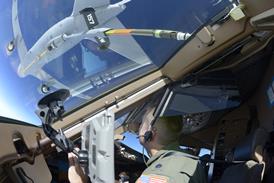DAVID LEARMOUNT / LONDON
US transport safety body says A300-600's in-flight recorders reveal accident was not the result of a single event
Almost everything that happened to seal the fate of American Airlines' flight AA587 appears to have taken place within 8s of the Airbus A300-600R's second encounter with a wake vortex, according to the US National Transportation Safety Board's (NTSB) latest assessment of the aircraft's on-board recorders.
All 260 people on the 12 November flight and five people on the ground are confirmed to have died.
During the 8s between crossing the wake of a Japan Airlines Boeing 747 and the flight data recorder (FDR) stopping, rudder deflections were simultaneous with three sideways accelerations from 0.3g to 0.8g, which the NTSB calls "significant" loads. It is not clear whether the tail fin, found away from the rest of the wreckage, had begun to separate at that point.
When the FDR stopped, the cockpit voice recorder (CVR) was still recording engine noise, believed to indicate that although the engines had separated shortly before impact, at that point they were still attached. The NTSB now says that it believes the CVR was working at - or close to - the moment of impact.
Witness reports of the last 20s of the aircraft's 103s-long flight appear to be consistent with the data reported by the NTSB, in that they said that the aircraft "wobbled", parts began to detach, and the aircraft fell to the ground in a spiral turn. When the FDR stopped - about 10s before impact, according to the NTSB's revised estimate - the aircraft's left wing was dropping through a 25í bank despite opposite aileron, pitch had dropped to 30í nose down, the aircraft was turning left at 10í/s, and the vertical acceleration was 2g.
Initial studies of the wreckage and the FDR show that the engines do not appear to have suffered any pre-crash damage, the gear and flaps were up and the thrust reversers were stowed and locked. The Federal Bureau of Investigation remains part of the inquiry team for now, but both parties say that there is no evidence of foul play.
The NTSB will be able to study the aft fuselage wreckage where the carbon fibre reinforced plastic tail fin was anchored, because the section where the six metal anchorage points were attached has been recovered. The fin is almost undamaged except for the points where severance took place. The metal attachment bolts have not broken, but the fin has separated cleanly at some points and torn away at others, leaving sections visible. This is the first time that a primary loadbearing composite structure has separated from an airliner.
Following orders from the US Federal Aviation Administration and France's Direction Generale de l'Aviation Civile, tail fin inspections by A300-600 and A310-300 operators have yielded no indications of damage to the composite structures of other aircraft so far.
It will be a year before all the data from the recorders and the wreckage has been analysed, the NTSB estimates.
Source: Flight International























